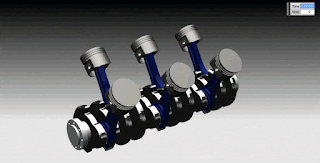I'm going to speak strictly about four-stroke engines in this post, for brevity. The simplest configuration for a piston engine of course is a single cylinder. It has the advantage of simplicity and low cost. Disadvantages are intermittent power, low power compared to multi-cylinder engines of the same displacement, and vibration due to inherently imbalanced rotating parts.
What about two cylinders? There are a few different ways to arrange engines with two cylinders. You can place the cylinders in a "V" arrangement:
Two cylinder "V" engines (also known as V-twins) have the advantage of having a lot of torque, or twisting force. They are also good engines to use on motorcycles, because they are narrow. They have the disadvantage of poor primary balance, and tend to require additional weight for counterbalancing. Harley Davidson is somewhat unique with their firing order on the V-twin engine. Both cylinders fire consecutively on the same turn of the crankshaft, rather than one piston firing each time it goes around. This firing order is under patent, and gives the engine its unique sound. It's also responsible for stretching the drive chain and jerkiness, and it's the reason why modern Harleys are all belt-driven.
Another two-cylinder arrangement is the flat engine. With this arrangement the pistons are always moving away from one another, or toward one another. As you may have guessed, this engine has excellent primary balance.
On a motorcycle, these are super-sweet cruising engines, due to the lack of vibration. However they are quite wide and if the motorcycle ever goes down, valve cover damage is almost inevitable without installing crash bars. Lean angle could also be an issue if the bike were to be ridden hard or raced.
Another possible arrangement for two cylinders is the inline twin. With this arrangement, the cylinders sit side by side on the crankshaft. These engines tend to vibrate due to rocking motion between the pistons across the crankshaft. This configuration was common in the mid-60s to mid 70's, but have pretty much fallen out of favor among manufacturers. Engines either are configured V-twin or have additional cylinders.
Below is a much less common arrangement with two cylinders. The opposed piston design. This arrangement still has two cylinders, but it has four pistons, with the combustion zone at the center of the cylinder. A bit complex, but multi-cylinder engines of this type were once fairly common in marine and rail propulsion.
What can we do with three cylinders that we can't do with two? Obviously we can place two or more cylinders inline. No big deal there. This configuration vibrates less than the inline twin of course.
However we can also make a W-shaped engine! Not great balance, but the oil won't tend to leak down into the cylinders, like a radial does.
The gif above is a "W" engine with 60 degrees between each cylinder. If you change the position of the middle cylinder to the bottom, you have placed the cylinders 120 degrees apart. Now you have the simplest possible radial engine, the 3 cylinder radial. I could not locate an animated image, so you will just have to use your imagination. Below is a 3 cylinder radial engine for model airplane use.
Below is a three cylinder, opposed, six piston engine, with three crankshafts. Crazy-looking, but common in rail and marine use in Britain. The Napier Deltic.
Not so odd-looking as the animation would lead you to believe.
Below, two different designs for a flat four cylinder engine. The upper engine is considered a V-4 engine with an angle of zero degrees. The pistons share a journal on the crankshaft, and piston pairs move in the same direction. This motor will have poor balance due to rocking motion between the front pair and rear pair of cylinders. With the Boxer engine beneath, piston pairs move in opposite directions, reducing vibration. They each have their own dedicated bearing on the crank shaft. There are also crankshaft support bearings between each cylinder. The boxer engine thus has five main crank support bearings instead of just three on the upper engine. This arrangement makes the boxer a much more robust engine.
Below, the Kinner B-5 Radial engine. 125 HP at 1900 RPM. 5.25:1 compression ratio, 7.2 liters.
Below, a six cylinder design that has not made it into production. I believe this one was envisioned by John DeLorean.
Inline six cylinder. Smooth, and a good design will have a main bearing between each cylinder for a robust engine.
Six cylinder boxer engine below, a mean motor! Just ask Porsche.
Below, the ubiquitous V-6 engine. Every modern vehicle under the sun is offered with one of these.
Below, a seven cylinder radial engine.
And below, the V-8. Powerhouse for muscle cars!
A straight eight cylinder engine is silky smooth, having perfect primary balance. Unfortunately it takes a loooong hood to put one up front of your car. Buick was the king of the straight 8 engine.
You can always move up to a V-12 though! Silky smooth!
Below, the Napier Sabre 24 cylinder opposed "H" configured engine.
Below, the same engine in person. Good for about 3500 HP.
End of the line for sophisticated flying piston engines. The Pratt&Whitney R-4360 28 cylinder radial engine.
You will notice the engine has a "twist" from right to left. The reason is that it's air-cooled. Each cylinder row is offset from the previous row to allow air to reach the cooling fins. The most powerful version of this engine made 3800 HP. These were mainly used in US military aircraft post WWII. Bombers, primarily. The Boeing 377 used them as well.



























No comments:
Post a Comment